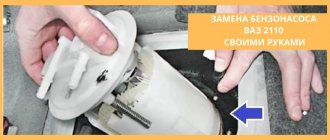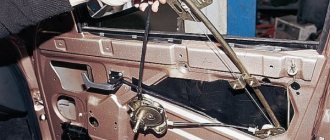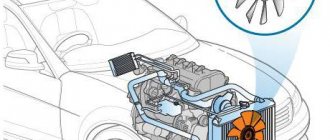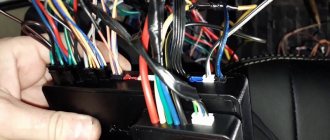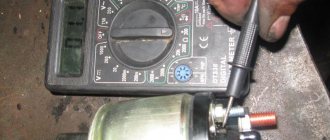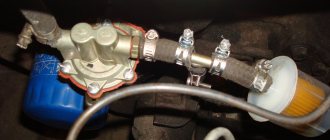When you turn on the ignition, the Check Engine light does not come on, or it lights up but goes out before the engine starts! In this article, I will tell you in detail about the reasons for this malfunction and give my recommendations on how to eliminate it.
According to the instructions, the “check engine” light should light up when the key is positioned 180 degrees in the ignition switch, and then, after starting the engine, go out. But it happens that in various situations it stops burning even before the engine starts.
Reasons why the fuel pump does not pump gasoline when the ignition is turned on
The gasoline pump serves to supply fuel from the tank and maintain the pressure in the line necessary for the operation of the injectors. Interruptions in the supply of gasoline lead to a disruption in the composition of the air-fuel mixture, which leads to poor-quality combustion and misfires, the engine begins to stall, respond sluggishly to the gas pedal or stall. If the fuel pump (FP) does not pump, the engine will not start at all.
Electric drive and filter
The fuel pump in the injection VAZ 2114 is an element of the fuel module, which is located in the car’s tank. It also includes:
- coarse filter;
- fuel level sensor;
- pipes for connection to the fuel line.
To get to the module, you need to remove the lower part of the rear seat, disconnect the wiring harness and unscrew the 8 screws securing its cover. Remove the entire device assembly. First of all, inspect the coarse filter. If it is clogged, replace it.
To test the electric motor, you will need to connect it directly to the battery terminals. If it is operating normally, “ring” the wiring and check the contact of the ground wire on the module cover. If the electric motor shows no signs of life, the question “why the fuel pump doesn’t pump” has finally found its solution.
It is not advisable to try to repair it yourself. Just buy a new motor and install it in place of the old one. And yet, you shouldn’t spend money on buying the entire module, which now costs about 3 thousand rubles. Buy the electric motor and a new filter separately. All this will cost you three times less.
Signs of fuel pump malfunctions
The main symptoms of fuel pump failure, as well as malfunctions in its operation, are:
- the car starts with difficulty, the engine runs unstable, there are dips, jerking when pressing the gas pedal, etc.;
- the pump does not pump after turning on the ignition, does not turn the starter and does not pump the fuel pump, the engine does not start;
There have also been cases when the fuel pump stops pumping while driving. In such a situation, the engine begins to malfunction and stalls immediately after the remaining gasoline in the fuel line is used up. The problem can occur either regularly or periodically.
The Check Engine light is not on - the reason is a dead battery.
The most common thing that could happen is a dead battery. The car stood motionless on the street or in the garage for a long time, and the battery was discharged. It is not difficult to check this development of events; it is enough to test whether the other lights on the instrument panel turn on, whether the headlights are on, etc. The battery for a modern car is a full-fledged power supply, and therefore no electronics of the car can function without it.
What can happen to the battery? Is it only possible to discharge due to downtime? It turns out not. In addition, due to temperature changes, the contacts of the battery terminals may oxidize and not transmit voltage. In addition, one of the terminals or both may simply move away and not sit very tightly, not providing proper contact. Another option is wiring coming from the battery. It is also recommended to check it, since the wires may break in any place.
Check Engine does not light up when you turn the key - the ECU system is faulty
Other secondary reasons
In addition, other secondary reasons are possible:
A failure in the system, because modern technologies, unfortunately, are not yet ideal and produce many errors;
- Faulty fuses and relays responsible for the check engine light and the car’s ignition system;
- Problems with the ignition switch, through which the system is turned on;
- Burnout of the light bulb itself inside the instrument panel.
If you are unable to find on your own the reason why the check goes out when you turn on the ignition, you need to immediately go to a service center. Remember that there may be a serious malfunction in the car, and your “iron friend” requires urgent help
The fuel pump does not work, the relay turns on.
Checking relay power.
In the case when the fuel pump relay turns on when the ignition is turned on, but the pump itself does not work, you need to check the power at terminal 87 of the fuel pump relay. To do this, touch terminal 87 of the relay socket with the output of the control lamp connected to the vehicle ground, and the lamp should light up. If the lamp does not light, it means the fuse has blown or there is a break in the wire.
If there is power at terminal 87, you should remove the relay from the socket, and instead place a jumper between pins 87 and 30. In this case, if the pump and connecting wires are working properly, the pump should start working and if this happens, the relay should be changed. If the pump does not start working, then, without removing the jumper, you need to touch the power wire on the fuel pump with a test lamp connected to the vehicle ground.
Checking the fuel pump power circuit.
If a submersible pump is installed on the car as part of the fuel module, you need to remove the connecting connector and touch one of the thick wires. When you touch one of them, the indicator lamp should light up. If the lamp does not light up on any of the wires, then it is necessary to eliminate the break in the wire from the fuel pump relay to the module connector or the pump itself, if the pump is of a remote type. One of the reasons for the break may be the anti-theft blocking of an installed non-standard alarm system.
In the case when the test lamp lights up on one of the thick wires of the connector or one of the terminals of the remote pump, you need to connect these terminals with a test lamp to each other. In this case, the control lamp should light up. If the lamp does not light, it is necessary to eliminate a break or poor contact in the wire connecting the pump to the vehicle ground.
If, when checking the wires and relay for turning on the fuel pump, no malfunction is detected, the electric motor of the fuel pump or its connection to the module connector is faulty. It is not difficult to find the cause by removing the fuel pump module from the tank. If there is poor contact with the connector, melting of the plugs will be visible. If melting is not noticed, then to check the pump itself, you can connect it to the battery. It should be taken into account that operating a submersible pump without liquid will damage the pump. A faulty pump should be replaced.
Why does the C heck E ngine indicator not light up?
So, the check must light up as soon as the vehicle’s SZ is turned on, and go out as soon as the engine starts. This indicates normal operation of the vehicle. Otherwise, if the check light comes on while driving or does not respond at all, diagnostics are needed at a service station.
First, let’s find out what the purpose of the indicator is. It turns out that the check translated from English literally means “check engine.” In other words, if the indicator lights up while the vehicle is moving, it means that the car’s ECU is sending a clear signal to the driver that there is some kind of malfunction in the operation of the internal combustion engine.
Unfortunately, the ECU is not capable of specifying the problem. On the other hand, if you know which systems the check is responsible for, you can draw the appropriate conclusions.
In the previous article I already managed to tell you about
It will not be so difficult to find the cause of the malfunction if the indicator does not light up after turning on the SZ. The driver got behind the wheel of the car, turned the key half a turn - the indicator should light up. If this does not happen, you need to try to test a few things yourself.
Signs of a fuel pump malfunction
Engine won't start
This is the main symptom of a faulty fuel pump. In the summer heat, a dying fuel pump may appear. The junction of the impeller with the rotor axis expands, and it rotates. You should check the fuel pressure from the rail and from the pump directly.
The service life of the fuel pump is determined by the owner's use of the vehicle. What is required for the fuel pump to last longer and not fail:
- Check the presence of water in the tank. For prevention, pour any pure alcohol into the tank. It mixes with water and burns out through the exhaust. There is a moisture displacer available in stores. Contains isopropyl alcohol.
Gasoline supply problems - common symptoms
Malfunctions of the fuel supply system are conventionally divided into 2 categories:
- The combustible mixture is not supplied to the cylinders at all.
- Gasoline is supplied intermittently or under insufficient pressure.
In the first case, the engine does not start and does not engage the starter during rotation, that is, it does not show signs of life. In such a situation, it is always easier to determine the cause of the breakdown.
When insufficient fuel enters the cylinders, the following symptoms appear:
- starting the power unit “from cold” is very difficult, the engine seizes and “sneezes”, it starts in 3–10 attempts;
- idling is unstable, the engine “troubles”;
- dynamic acceleration becomes impossible - a sharp opening of the throttle causes a long dip and deceleration;
- when the driver releases the accelerator pedal, the engine often stalls;
- The car has difficulty climbing hills and accelerates slowly when fully loaded.
The cause of the above phenomena may be a malfunction of the fuel pump or other elements of the system, and the primary symptoms are almost the same. To carry out an accurate diagnosis, you need to understand how the car's power system works.
The fuel pump does not pump when the ignition is turned on
First of all, you need to check the fuel pump terminals and the power to them. In the photo, the terminals were worn out, which caused the contact to close and the fuel pump to melt.
What to do if such a situation arises. The verification algorithm is described below. Briefly check the presence of voltage at the fuel pump terminals. Based on this, further conclusions are drawn.
Checking the fuel pump circuit
Checking the power circuit.
If you know that the pump is working (to do this you need to gain access to it, remove it and connect it to an alternative power source), then the reason should be looked for in the car's wiring. To do this, the control light should be connected to the gray wire that goes to the pump.
This is exactly what is a plus. If the light does not light up, then power is not supplied to the unit.
Checking relays and fuses
Here you should initially check the fuses and relays. The fuse box is located behind the left of the driver under the dashboard, and therefore is not easy to access. You will have to unscrew two bolts and remove the decorative protective cover.
If these components are faulty, they should be replaced. The relay is checked in the same way as the pump, by connecting a test light to the input and output . The fuse can be checked visually.
The fuel pump relay is marked with a green arrow.
If the car still does not start, you should check the connector block. It is located behind the driver's side fuse box in the passenger compartment. Here you can also use a test light or tester, with which you can check the voltage at the inputs/outputs.
Video why the Check Engine does not light up when starting the engine
Often we notice malfunctions in the car's operation directly while driving it. However, it also happens when you sit comfortably in the driver’s seat, insert the key into the ignition with the usual movement and turn it 180°, and instead of the usual “roar” of the engine, you hear nothing. It is clear that such a situation does not promise anything good, but if you have to face it, you will have to solve the problem immediately. After all, not everyone can afford to remain without a car. In today's article you can learn all about the most common ignition faults, diagnostic features of this car system and troubleshooting all faults.
What to do if the car's ignition does not turn on?
The lack of response from the ignition switch to turning the key is probably the worst thing a car owner can expect. On the one hand, the breakdown may be completely trivial, but on the other hand, try to find this breakdown first. After all, under the hood of a car there are so many systems and individual parts that are associated with them that you can spend several days in a row searching for the cause of the malfunction of the latter. Almost every component can cause the car to not start.
So, let's figure out what to do if the ignition does not turn on. Of course, it is necessary to carry out an initial diagnosis of the car and try to determine what is wrong. In particular, some ignition faults can be determined even by a number of external signs. The fact is that they may coincide with malfunctions in the fuel supply systems to the engine combustion chamber. In this regard, primary diagnosis must be comprehensive.
External signs of an ignition malfunction include:
— difficulties when attempting to start the engine or the inability to do so;
Engine instability at idle speed;
A noticeable decrease in car engine power;
Increased gasoline consumption during normal vehicle use.
Undoubtedly, the voiced signs may appear if the ignition, although with difficulty, works. However, many car owners do not attach much importance to them and begin to clutch their heads even when the ignition does not turn on at all. In such a situation, it will be very difficult to correct the situation, and the most correct advice would be as follows: immediately contact specialists. But if you do not have such an opportunity, and you are eager to try to get out of the situation yourself, first of all you should familiarize yourself with the most common ignition faults.
The most common ignition faults: should you panic?
In order to determine the breakdown and, of course, correct it, you need to know about the existence of different ignition systems that can be found on cars today:
— contact system
– high voltage in the system and its transmission to the cylinders is carried out using contacts;
— contactless
– the contact breaker is replaced here by a contactless sensor;
— electronic
– high voltage in the system and its transmission to the cylinders is carried out using a special electronic device.
But no matter what system is installed on your car, the faults may be identical. The most common for all of the above systems are the following:
— malfunctions associated with incorrect operation or burnout of spark plugs;
Ignition coil malfunction;
Broken connections in the electrical circuits of the car - chafing of wires, loose connections, oxidized contacts).
Since the electronic system is the most common for modern cars, it is worth noting another very common cause of failure for it. Of course, a similar situation can be caused by a malfunction in the electronic control unit of the car, which directly affects the operation of the ignition. Most often, the reason lies in the presence of defects in the input sensors.
With a non-contact system, the situation is even worse, since even the sensor-distributor cover can interfere with its operation. Also, if the ignition of the contactless system does not turn on, the reason may lie in a malfunction of the transistor switch or ignition timing regulators.
But in general, there can be a lot of reasons, although with the passing of the contact ignition system into the past, most of them have ceased to be relevant for modern car owners:
- improper operation. For example, low-quality gasoline was poured into the tank, or the frequency of servicing the gas pump was very long;
The system included low-quality structural elements, which include spark plugs, high- and low-voltage wires, and the ignition coil itself;
The influence of a number of external factors on the car and its systems. We are talking not only about the impact of atmospheric phenomena, but also about possible mechanical damage.
Experts divide all ignition malfunctions into three general categories: problems related to electronics, problems with the ignition coil, and low-quality fuel. Of course, such a classification is very primitive, but this is what you need to focus on if the ignition does not turn on.
Ignition malfunctions associated with incorrect connection and operation of automotive electronics Since this is the most common cause of ignition failure, the first thing you need to pay attention to is the fuses.
Of course, not all ignition systems have fuses, but if they do, be sure to make sure that none of them are blown. If this is not the case, then the reason may lie in:
1. Car battery corrosion.
Due to long-term use and the influence of external factors, the power supply connectors become dirty and may even become rusty. Because of this, the connection between the battery and the rest of the “organism” of the car is broken. To understand whether this is actually the case, you should either clean the terminals of rust or replace the battery. If the car still does not start, you will have to look further for the reason.
2. A battery that just died.
You can check the current strength of the power supply using a conventional tester. However, this can also be understood by external signs: if a slight jolt still occurs when you turn on the starter, it means that the battery is really discharged.
3. Broken ignition switch.
Try turning the key to the first position and see if the red lights on the instrument panel light up. If not, the problem is in the ignition switch. Also, if, when you try to start the car, the warning lights do not go out or even dim, the reason may be a faulty ignition switch.
4. Faulty starter connections.
This element can also become corroded over time. If there is voltage in the system, but the starter does not respond to turns of the key, it will most likely need to be replaced.
Ignition coil malfunctions
To determine the performance of the ignition coil, you must use a special device called a multimeter, which is designed to measure the resistance force. If after testing you find that the coil does not work, it must be replaced immediately.
Along with the coil, it is important to check the ignition distributor cap. The fact is that due to temperature changes and high humidity, water can accumulate under its lid. If, after removing it from the distributor, you find condensation, wipe the cover with a dry cloth. Also pay attention to whether there are any cracks on it. After the cover is reinstalled, try starting the car again.
If the ignition does not turn on, the reason may also be hidden in the wire of its coil.
It can either break or burn out due to a short circuit. If there are obvious marks on it, the coil must be replaced.
Ignition malfunctions caused by the use of bad fuel
Bad fuel is also a very common reason why a driver cannot start a car. If we are talking about injection engines, then we can name a number of subsystems that can cause a similar situation. And the main difficulty is that such problems can only be diagnosed through serious computer diagnostics. However, we will still tell you about some things that can be implemented even in the garage:
1. Check the electrical systems that are directly responsible for fuel injection.
You'll need to locate the connector on the top of the injector itself, and also inspect the connections on the intake and on the cylinder heads. Ideally, all electrical connections should be checked.
2. Relay and fuel pump.
To obtain 100% reliable diagnostics, you need special equipment. If it is not there, then the only thing you can check is, again, the electrical connections of the indicated elements.
Replacing the ignition coil, as well as its lock.
We hope you will be able to not only determine the cause of the ignition malfunction, but also successfully eliminate it. Moreover, you already have the necessary knowledge for this.
One of the most important elements is the electric fuel pump, which is located in the fuel tank of the car. The fuel pump pumps fuel into the system from, creating a certain pressure.
Auto repair experts identify the following common fuel system problems that are related to the fuel pump:
- The fuel pump pumps poorly and does not create the required pressure;
- the fuel pump does not pump when the ignition is turned on;
Considering that the fuel pump is an electromechanical device, the most common fuel pump malfunctions are related to both the mechanical and electrical parts. Next, we will look at what signs indicate a breakdown of the fuel pump and why the fuel pump stops pumping partially or completely.
Read in this article
The principle of operation of the fuel pump
The operation of the pump is controlled by a controller. At the same time, its control scheme is quite interesting. There is no pressure sensor in the car system, and therefore it is maintained by a pressure regulator. It is located near the pump in the tank.
New and old fuel pressure regulator
The regulator has a valve that can open only at a certain moment, namely when there is sufficient pressure in the system (4 Bar).
In this case, fuel will not flow into the return line either. When the ignition is turned on, the pump begins to pump fuel into the system, after which the regulator valve opens and remains in this position throughout the engine operation.
How to check the functionality of the pump?
If the engine is absolutely “dead”, follow this algorithm:
- Turn on the ignition without turning the starter. A working electric fuel pump should respond with a quiet but distinct buzzing sound coming from the rear row of seats. If there is no sound, go to the next step.
- Using the car's operating instructions, find the number of the fuse that protects the pump's power circuit. Try replacing it; if unsuccessful, check the wiring and clean the contacts from oxides.
- If previous manipulations did not produce results, you need to measure the fuel pressure in the fuel rail.
Pressure measurement is also practiced when identifying symptoms of insufficient fuel supplied to the cylinders of the power unit.
To take measurements and compare signs of a breakdown with a fuel pump or other element, you need to reset the initial fuel pressure in the system, no matter how low it turns out to be.
If the pressure is below normal, proceed to find out the reasons according to the recommendations:
- There are pressure surges in the range of 0.2...0.3 Bar at idle - look for a problem in the filters. Surely the coarse mesh or secondary element is clogged.
- Use pliers to pinch the return line hose coming out of the RTD. The gasoline pressure should increase to 5 Bar, with the new pump - to 6 Bar. If the readings are 4 Bar or lower, the cause should be sought in the regulator or the pumping unit itself.
- The best way to identify a fuel pump malfunction is to exclude other parts of the system and take a measurement directly at the outlet fitting. If the pressure gauge shows 5 Bar, the unit is working properly and you need to change the RTD, which dumps half of the fuel into the tank.
To measure the pressure at the outlet of the electric fuel pump, you will need to remove the rear seat, dismantle the service hatch and connect a pressure gauge to the supply fitting of the unit.
Here you may need adapters in the form of plastic clamps or threaded tubes. Before changing the pressure regulator, make sure that the gas lines and filters are of normal capacity. Due to refueling with low-quality fuel, even the flow area of 8–10 mm tubes can become clogged. Then the pressure gauge on the ramp and pump will show different values, and the RTD will regularly drain excess fuel into the tank.
How to remove the fuel pump Cherie Amulet
- Be sure to turn off the power to the on-board electrical system. We simply remove the negative terminal from the battery .
- Open the trunk and raise the flooring . For ease of work, you can remove the rolling tool and the tool lying next to it.
- Open the cover behind which the fuel module is hidden. The lid is held on by 3 screws.
Advantages of injection models
The main function of the pump is to supply fuel to the combustion chamber. It must meet certain requirements. The main criterion is pressure.
The pumps for injection and carburetor engines are different. Thanks to the engine with direct fuel injection, there is no need for preliminary preparation of the combustible mixture. As you know, the carburetor is the weak link. Difficult adjustments, clogged jets, difficult starting in cold weather create inconvenience for owners of classic VAZ brands.
Tens and VAZ-2112 internal combustion engines have significant advantages. Let us note the advantages of injection units:
- support for environmental standards;
- direct injection into the combustion chamber;
- fuel economy;
- system reliability;
- increased engine power;
- starting a cold unit without warming up;
- dispensing a portion of the mixture;
- The fuel module is controlled electronically.
Unfortunately, the injector has a number of disadvantages. Maintenance and repairs have to be carried out at a service station. It also requires qualified personnel and a computer to determine the malfunction of electronic components. Let us point out other disadvantages:
- design complexity;
- high requirements for the octane number of gasoline;
- complex diagnostics and repairs;
- expensive spare parts and equipment.
Fault repair
If there is no power to the block, we begin troubleshooting by checking the fuses of the fuel pump power supply circuit. They are located on a special separate panel located in the car interior under the glove compartment.
Fuel pump fuse VAZ 2107
The middle relay and fuse F3 located nearby are responsible for the operation of the fuel pump.
1 – fuse, power circuits of the main relay;
Connection diagram
Above is an electrical diagram of a standard fuel injection pump. After successful interrogation of the immobilizer, the ECM (controller) supplies power to the coil winding of the fuel pump relay (terminals 85, 86). As a result of electromagnetic induction, contacts 30 of the power source (constant “+” from the battery protected by fuse X) and 87 are closed, which turns on the fuel pump. Main disadvantages:
- blown fuse; Attention! Replace the blown fuse with one of the correct rating. Installing a fuse with a higher current rating may cause the vehicle to catch fire.
- Oxide deposits in connectors, burnout of power contacts of the fuel pump relay. Parasitic resistance leads to a decrease in current in the circuit and a decrease in pump efficiency;
- abrasion, kinks of wires;
- break the clamp of the power connector leading to the fuel module. Contact is often broken when driving over uneven surfaces.
The principle of operation of the fuel pump
The operation of the pump is controlled by a controller. At the same time, its control scheme is quite interesting. There is no pressure sensor in the car system, and therefore it is maintained by a pressure regulator. It is located near the pump in the tank.
New and old fuel pressure regulator
The regulator has a valve that can open only at a certain moment, namely when there is sufficient pressure in the system (4 Bar).
In this case, fuel will not flow into the return line either. When the ignition is turned on, the pump begins to pump fuel into the system, after which the regulator valve opens and remains in this position throughout the engine operation.
Where is the fuel filter located?
The fuel filter (TF) on the VAZ-21099i is designed to clean gasoline from debris, dirt and various impurities; it is a monolithic structure with a rigid metal body and a filter element inside. The frequency of its replacement is every 20-30 thousand km of the distance traveled, also if the car begins to move jerkily, and diagnostics showed that the fuel pump is clogged.
It’s easy to find out where the fuel filter is located; to do this, you need to install the car on an inspection hole or a car lift. The TF is located on the bottom of the body, next to the rear beam and the gas tank, and is secured with a special clamp, which is tightened with a bolt and nut.
Before you start changing the filter, you need to relieve the fuel pressure, otherwise when you unscrew the fuel fittings, gasoline will splash under high pressure. You can relieve pressure in the line using a special nipple located at the rear of the fuel rail. Before starting such an operation, it is necessary to prepare a plastic container into which gasoline should be poured, then unscrew the safety cap.
To release the pressure, you can use a standard flat-head screwdriver; when you press the nipple valve, gasoline will come out of the system.
After removing fuel from the line, we proceed to replacing the fuel pump.
Master node of the system
The VAZ-2110 fuel pump is equipped with an electric drive. Its body is lowered into the fuel tank. Gasoline is both a pumpable fuel and a coolant. It should be remembered that traveling with an empty tank is fraught with overheating of the VAZ-2110 injector fuel pump.
This electrical device is an independent unit. Accordingly, its operation does not depend on the state of other mechanisms. A necessary condition for rotating the VAZ-2110 fuel pump rotor is maintaining normal voltage on the on-board network.
The voltage comes through the ignition switch. When the key is moved to position 1, the circuit is closed to turn on the drive. The VAZ fuel pump fills the fuel rail. The engine is ready to start.
If symptoms of poor fuel system performance occur, the pump should be checked. We list the signs that make it possible to replace the VAZ-2110 fuel pump:
- the car is malfunctioning;
- accelerates poorly;
- twitches while driving;
- won't start at all
- gasoline does not flow to the ramp.
First of all, a hearing test is performed. After turning the ignition key to position No. 1, there should be a noise under the rear seat. The sound lasts for a couple of seconds. This means that the pump has pumped up the required pressure.

